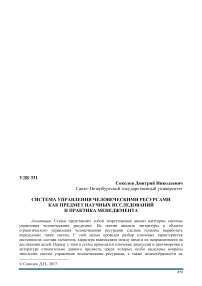Система управления человеческими ресурсами как предмет научных исследований и практика менеджмента
Автор: Соколов Дмитрий Николаевич
Журнал: Вестник факультета управления СПбГЭУ @vfu-spgeu
Рубрика: Управление персоналом: современные вызовы и механизмы модернизации
Статья в выпуске: 1-2, 2017 года.
Бесплатный доступ
Статья представляет собой теоретический анализ категории системы управления человеческими ресурсами. На основе анализа литературы в области стратегического управления человеческими ресурсами сделана попытка выработать определение таких систем. С этой целью проведен разбор ключевых характеристик системности: состава элементов, характера взаимосвязи между ними и их направленности на достижения целей. Наряду с этим в статье приводятся ключевые дискуссии и противоречия в литературе относительно данного предмета, среди которых особо выделены вопросы типологии систем управления человеческими ресурсами, а также целесообразности их дифференциации между различными группами персонала. Статья может представлять интерес как для исследователей, планирующих использование категорию систем управления человеческими ресурсами в своих трудах, так и для практиков, ставящих перед собой цель глубже разобраться в содержании управления персоналом.
Управление человеческими ресурсами, системы учр, стратегическое учр, практики учр, интеграция практик учр
Короткий адрес: https://sciup.org/148319494
IDR: 148319494 | УДК: 331
Список литературы Система управления человеческими ресурсами как предмет научных исследований и практика менеджмента
- Агошкова Е.Б., Ахлибинский Б.В. Эволюция понятия системы//Вопросы философии. 1998. №7. С. 170-179
- Базаров Т.Ю. Управление персоналом: Учебник/Т.Ю. Базаров. 8-е изд., стер. М.: Издательский центр «Академия», 2010. 224 с.
- Управление персоналом организации: Учебник/Под ред. А.Я. Кибанова. 4-е изд., доп. и перераб. М.: ИНФРА-М, 2010. 695 с.
- Alewell, D. and Hansen, N.K. (2012). Human resource management systems -a structured review of research contributions and open questions. The German Journal of Industrial Relations, 19(2), 90-123.
- Armstrong, M. (2009). Armstrong's Handbook of Human Resource Management Practice. 11th Edition. London Kogan Page.
- Arthur, J.B. and Boyles, T. (2007). Developing the Human Resource System Structure: A Levels-based Framework for Strategic HRM Research. Human Resource Management Review. 17(1), 77-92.
- Becker, B.E., and Huselid, M.A. (1998), High Performance Work Systems and Firm Performance: A Synthesis of Research and Managerial Implications, Research in Personnel and Human Resources Management, 16, 53-101.
- Collings, D.G., and Mellahi, K. (2009). 'Strategic talent management: a review and research agenda'. Human Resource Management Review, 19(4), 304-313.
- Delery, J. E. (1998). Issues of fit in strategic human resource management: Implications for research. Human Resource Management Review, 8, 289-310.
- Garaus, C., GUttel, W.H., Konlechner, S., Koprax, I., Lackner, H., Link, K., & MUller, B. (2015). Bridging knowledge in ambidextrous HRM systems: empirical evidence from hidden champions, The International Journal of Human Resource Management.
- Godard, J. (2004) A Critical Assessment of the High-Performance Paradigm. British Journal of Industrial Relations, 42, (2), pp. 349-378.
- Hauff, S., Alewell, D. and Hansen, N.K. (2014). HRM systems between control and commitment: occurrence, characteristics and effects on HRM outcomes and firm performance. Human Resource Management Journal 24(4), 424-441.
- Huselid, M.A. 1995. The impact of human resource management practices on turnover, productivity, and corporate financial performance. Academy of Management Journal 38(3), 635-872.
- Jiang, K., Lepak, D.P., Han, K., Hong, Y., Kim, A., & Winkler, A.-L. (2012). Clarifying the construct of human resource systems: Relating human resource management to employee performance. Human Resource Management Review, 22(2), 73-85.
- Kepes, S., Delery, J.E. (2008). HRM Systems and the Problem of Internal Fit. In Box-hall, P., Purcell, J., Wright P. M., (Ed.), Oxford Handbook of Human Resource Management. Oxford University Press.
- Krausert A. (2014). HRM Systems for knowledge workers: Differences among top managers, middle managers, and professional employees. Human Resource Management, 53(1), 67-87.
- Lepak, D.P., & Snell, S.A. (1999). The human resource architecture: Toward a theory of human capital allocation and development. Academy of Management Review, 24, 31-48.
- Lepak, D.P., & Snell, S.A. (2002). Examining the human resource architecture: The relationships among human capital, employment, and human resource configurations. Journal of Management, 28, 517-543.
- Lepak, D.P., Liao, H., Chung, Y., & Harden, E.E. (2006). A conceptual review of human resource management systems in strategic human resource management research. Research in Personnel and Human Resources Management, 25, 217-271.
- Marescaux, E., De Winne, S., & Sels, L. (2013). HR practices and affective organisational commitment: (When) does HR differentiation pay off? Human Resource Management Journal, 23, 329-345.
- Monks, K., Kelly, G., Conway, E., Flood, P., Truss, K. and Hannon, E. (2013). Understanding how HR systems work: the role of HR philosophy and HR processes. Human Resource Management Journal 23(4), 379-395.
- Yan, M., Peng, K.Z., & Francesco, A.M. (2011).The differential effects of job design on knowledge workers and manual workers: A quasi-experimental field study in China. Human Resource Management, 50, 407-424.


